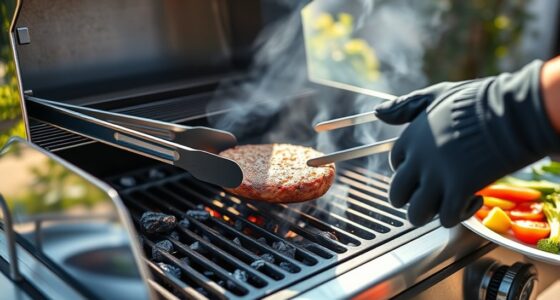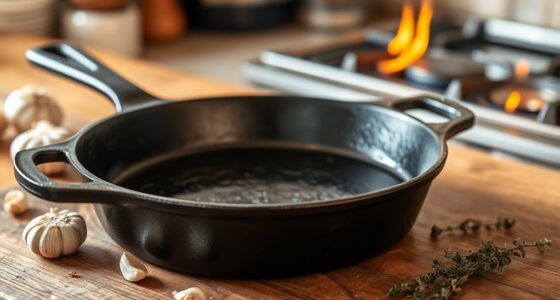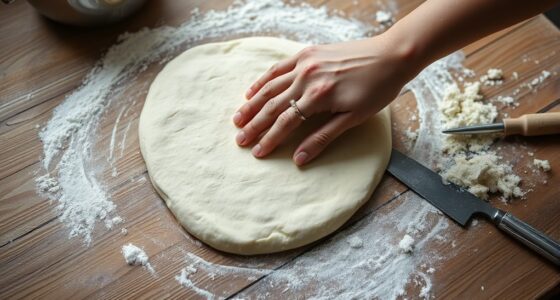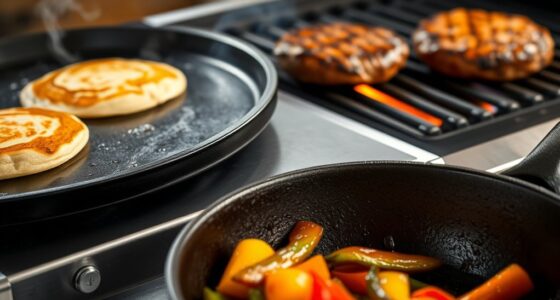In baking, yeast ferments sugars in the dough to produce carbon dioxide and alcohol, causing it to rise and develop a porous texture. Chemical leaveners like baking soda and baking powder release gases quickly when mixed with moisture and heat, creating a rise and tender crumb. Understanding how these leavening agents work helps you control dough expansion, ensuring your baked goods turn out perfect. Keep exploring to uncover more science behind your favorite recipes.
Key Takeaways
- Yeast ferments sugars, producing carbon dioxide that causes dough to rise and develop a porous structure.
- Leaveners like baking powder release gases through chemical reactions, aiding dough expansion.
- Proper fermentation timing and temperature optimize gas production and dough elasticity.
- Hydration and kneading develop gluten, trapping gases and providing structure for leavened baked goods.
- Controlling yeast activity and leavening agents ensures desired rise, texture, and flavor in baking.
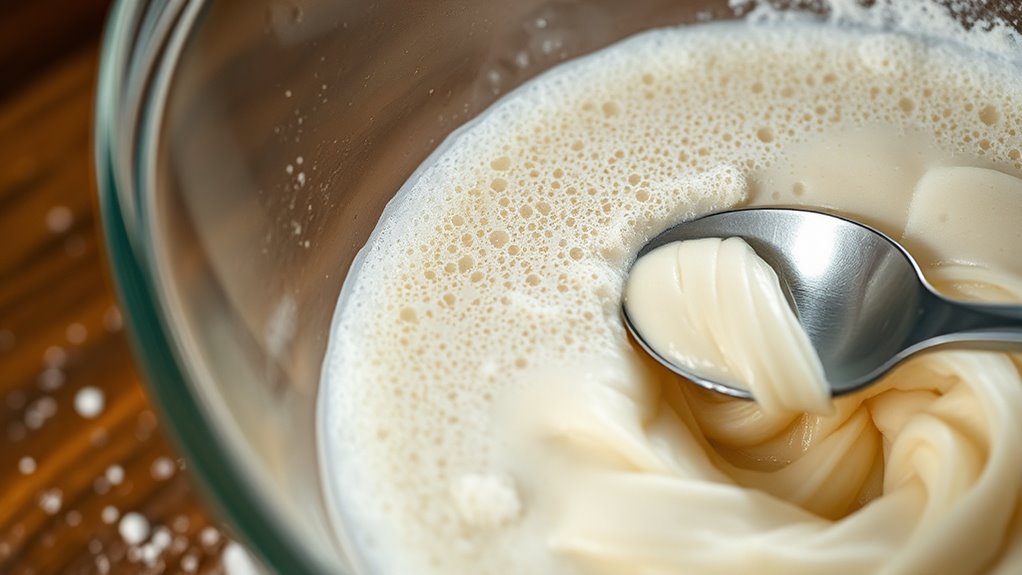
Have you ever wondered what makes baking both an art and a science? It’s the intricate balance of chemistry, biology, and technique that transforms simple ingredients into delicious baked goods. One of the key scientific processes at play is gluten development. When you mix flour with water, gluten proteins — glutenin and gliadin — begin to form a network. As you knead or stir, these proteins bond, creating a stretchy, elastic structure that gives bread its chewy texture and holds gases produced during fermentation. Proper gluten development is essential; too little, and your baked item might be dense or crumbly, too much, and it can become tough. The process of gluten formation isn’t random; it’s driven by the physical action of kneading and the hydration of flour, which unlocks the proteins’ potential. This network traps carbon dioxide, allowing the dough to rise and achieve its airy, light texture.
Closely tied to this is the fermentation process. When you add yeast to your dough, it comes alive — feeding on sugars and releasing carbon dioxide and alcohol in a process called fermentation. This isn’t just about rising; it’s about flavor development and texture improvement. As yeast ferments, it produces gases that get trapped within the gluten network, causing the dough to expand and develop a porous structure. Over time, fermentation also creates complex flavors, which are why longer fermentation times often result in richer, more nuanced baked goods. The yeast’s activity is influenced by temperature, moisture, and the amount of sugar present, making timing and conditions crucial. If you ferment too quickly or too slowly, the texture and taste can suffer. The fermentation process is a delicate dance: too much fermentation can overstretch the gluten, leading to a weak structure, while too little may leave your bread dense and flat.
Understanding these scientific principles helps you manipulate the baking process for better results. By controlling gluten development, you can fine-tune the dough’s elasticity and strength. Managing fermentation ensures your bread rises properly and develops the desired flavor profile. In essence, mastering the science behind gluten and yeast activity turns baking from guesswork into an artful craft. It allows you to predict outcomes, troubleshoot issues, and create baked goods with consistent quality. When you grasp how these processes work, baking becomes not just a task but an exploration of chemistry and biology in action—transforming simple ingredients into something extraordinary through the precise application of scientific principles.
Frequently Asked Questions
How Does Altitude Affect Yeast Activity in Baking?
At high altitudes, yeast activity speeds up because the air pressure is lower, causing dough to rise faster. You should make altitude adjustments by reducing yeast amounts and increasing liquid to prevent over-expansion. This helps control the rise, ensuring your baked goods have the right texture. By understanding altitude effects, you can tweak recipes to maintain the perfect rise and avoid problems like collapsing or uneven baking.
Can Non-Traditional Leaveners Replace Yeast Effectively?
Your baking can become legendary by replacing yeast with non-traditional leaveners, but it’s a delicate dance. These alternatives trigger different chemical reactions, which may not produce the same dough elasticity and rise as yeast. Baking success hinges on understanding these reactions, so you might need to tweak recipes or combine leaveners for the best results. Don’t give up—experiment, and you’ll discover new, exciting ways to create fluffy, delicious baked goods!
What Role Does Temperature Play in Fermentation Speed?
Temperature control directly impacts fermentation rate; warmer temperatures accelerate yeast activity, speeding up fermentation, while cooler temperatures slow it down. You should keep your dough in a warm, consistent environment to guarantee ideal fermentation speed. If temperatures fluctuate, it can lead to uneven rising or over-fermentation. By maintaining steady, appropriate temperatures, you help the yeast work efficiently, resulting in better dough development and a desirable texture in your baked goods.
How Do Preservatives Impact Yeast Fermentation?
Imagine opening a jar of jam and noticing it lasts longer; preservatives create a similar effect in baking. They inhibit yeast activity by slowing or halting fermentation, maintaining the dough’s freshness. Preservative effects include preventing spoilage and extending shelf life, but too much can hinder yeast fermentation, leading to less rise. You need to balance preservative use carefully to ensure your baked goods develop proper leavening while staying fresh longer.
What Are Common Mistakes That Inhibit Leavening?
You might inhibit leavening if you overproof your dough, causing it to collapse and lose its rise. Inadequate kneading can also prevent proper gluten development, resulting in dense bread that doesn’t rise well. Make sure to monitor proofing times and knead thoroughly to develop structure. Avoid rushing the process, and you’ll achieve better leavening and a lighter, fluffier baked good.
Conclusion
Now that you’ve uncovered the science behind yeast and leaveners, you hold the key to perfect baked goods. With this knowledge, you can tweak recipes like a seasoned alchemist, ensuring every loaf rises just right. Remember, baking isn’t merely a craft but a delightful interplay of chemistry and artistry—think of it as your own culinary “Renaissance.” So, go forth and create with confidence, turning simple ingredients into masterpieces that would make even Leonardo smile.


